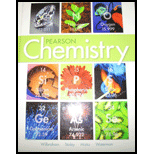
Chemistry 2012 Student Edition (hard Cover) Grade 11
12th Edition
ISBN: 9780132525763
Author: Prentice Hall
Publisher: Prentice Hall
expand_more
expand_more
format_list_bulleted
Question
Chapter 2.4, Problem 37LC
Interpretation Introduction
Interpretation: According to the law of conservation of mass, the situation when the mass is conserved should be explained.
Concept Introduction: In a chemical change, the
Expert Solution & Answer
Answer to Problem 37LC
During a
Explanation of Solution
The mass of reactants is always equal to the mass of products during any chemical reaction. This observation of the equal mass of reactants and products is stated by the law of conservation of mass, which states that mass is conserved in any chemical or physical change.
Chapter 2 Solutions
Chemistry 2012 Student Edition (hard Cover) Grade 11
Ch. 2.1 - Prob. 1LCCh. 2.1 - Prob. 2LCCh. 2.1 - Prob. 3LCCh. 2.1 - Prob. 4LCCh. 2.1 - Prob. 5LCCh. 2.1 - Prob. 6LCCh. 2.1 - Prob. 7LCCh. 2.1 - Prob. 8LCCh. 2.1 - Prob. 9LCCh. 2.1 - Prob. 10SP
Ch. 2.1 - Prob. 11SPCh. 2.2 - Prob. 12LCCh. 2.2 - Prob. 13LCCh. 2.2 - Prob. 14LCCh. 2.2 - Prob. 15LCCh. 2.2 - Prob. 16LCCh. 2.2 - Prob. 17LCCh. 2.2 - Prob. 18LCCh. 2.2 - Prob. 19LCCh. 2.3 - Prob. 20SPCh. 2.3 - Prob. 21SPCh. 2.3 - Prob. 22LCCh. 2.3 - Prob. 23LCCh. 2.3 - Prob. 24LCCh. 2.3 - Prob. 25LCCh. 2.3 - Prob. 26LCCh. 2.3 - Prob. 27LCCh. 2.3 - Prob. 28LCCh. 2.3 - Prob. 29LCCh. 2.3 - Prob. 30LCCh. 2.3 - Prob. 31LCCh. 2.4 - Prob. 32LCCh. 2.4 - Prob. 33LCCh. 2.4 - Prob. 34LCCh. 2.4 - Prob. 35LCCh. 2.4 - Prob. 36LCCh. 2.4 - Prob. 37LCCh. 2.4 - Prob. 38LCCh. 2 - Prob. 39ACh. 2 - Prob. 40ACh. 2 - Prob. 41ACh. 2 - Prob. 42ACh. 2 - Prob. 43ACh. 2 - Prob. 44ACh. 2 - Prob. 45ACh. 2 - Prob. 46ACh. 2 - Prob. 47ACh. 2 - Prob. 48ACh. 2 - Prob. 49ACh. 2 - Prob. 50ACh. 2 - Prob. 51ACh. 2 - Prob. 52ACh. 2 - Prob. 53ACh. 2 - Prob. 54ACh. 2 - Prob. 55ACh. 2 - Prob. 56ACh. 2 - Prob. 57ACh. 2 - Prob. 58ACh. 2 - Prob. 59ACh. 2 - Prob. 60ACh. 2 - Prob. 61ACh. 2 - Prob. 62ACh. 2 - Prob. 63ACh. 2 - Prob. 64ACh. 2 - Prob. 65ACh. 2 - Prob. 66ACh. 2 - Prob. 67ACh. 2 - Prob. 68ACh. 2 - Prob. 69ACh. 2 - Prob. 70ACh. 2 - Prob. 71ACh. 2 - Prob. 72ACh. 2 - Prob. 73ACh. 2 - Prob. 74ACh. 2 - Prob. 75ACh. 2 - Prob. 76ACh. 2 - Prob. 77ACh. 2 - Prob. 78ACh. 2 - Prob. 79ACh. 2 - Prob. 80ACh. 2 - Prob. 81ACh. 2 - Prob. 82ACh. 2 - Prob. 83ACh. 2 - Prob. 84ACh. 2 - Prob. 85ACh. 2 - Prob. 86ACh. 2 - Prob. 87ACh. 2 - Prob. 88ACh. 2 - Prob. 89ACh. 2 - Prob. 90ACh. 2 - Prob. 93ACh. 2 - Prob. 94ACh. 2 - Prob. 95ACh. 2 - Prob. 1STPCh. 2 - Prob. 2STPCh. 2 - Prob. 3STPCh. 2 - Prob. 4STPCh. 2 - Prob. 5STPCh. 2 - Prob. 6STPCh. 2 - Prob. 7STPCh. 2 - Prob. 8STPCh. 2 - Prob. 9STPCh. 2 - Prob. 10STPCh. 2 - Prob. 11STPCh. 2 - Prob. 12STPCh. 2 - Prob. 13STPCh. 2 - Prob. 14STP
Knowledge Booster
Similar questions
- Draw the mechanism to make the alcohol 2-hexanol. Draw the Mechanism to make the alcohol 1-hexanol.arrow_forwardDraw the mechanism for the formation of diol by starting with 1-pentanal in... basic conditions then acidic conditions then draw the mechanism for the formation of a carboxylic acid from your product.arrow_forwardIdentify each chiral carbon as either R or S. Identify the overall carbohydrates as L or Darrow_forward
- Ethers can be formed via acid-catalyzed acetal formation. Draw the mechanism for the molecule below and ethanol.arrow_forwardHOCH, H HO CH-OH OH H OH 11 CH₂OH F II OH H H 0 + H OHarrow_forwardDraw the mechanism for the formation of diol by starting with one pen and all in... basic conditions then acidic conditions then draw the mechanism for the formation of a carboxylic acid from your product.arrow_forward
arrow_back_ios
SEE MORE QUESTIONS
arrow_forward_ios
Recommended textbooks for you
 ChemistryChemistryISBN:9781305957404Author:Steven S. Zumdahl, Susan A. Zumdahl, Donald J. DeCostePublisher:Cengage Learning
ChemistryChemistryISBN:9781305957404Author:Steven S. Zumdahl, Susan A. Zumdahl, Donald J. DeCostePublisher:Cengage Learning ChemistryChemistryISBN:9781259911156Author:Raymond Chang Dr., Jason Overby ProfessorPublisher:McGraw-Hill Education
ChemistryChemistryISBN:9781259911156Author:Raymond Chang Dr., Jason Overby ProfessorPublisher:McGraw-Hill Education Principles of Instrumental AnalysisChemistryISBN:9781305577213Author:Douglas A. Skoog, F. James Holler, Stanley R. CrouchPublisher:Cengage Learning
Principles of Instrumental AnalysisChemistryISBN:9781305577213Author:Douglas A. Skoog, F. James Holler, Stanley R. CrouchPublisher:Cengage Learning Organic ChemistryChemistryISBN:9780078021558Author:Janice Gorzynski Smith Dr.Publisher:McGraw-Hill Education
Organic ChemistryChemistryISBN:9780078021558Author:Janice Gorzynski Smith Dr.Publisher:McGraw-Hill Education Chemistry: Principles and ReactionsChemistryISBN:9781305079373Author:William L. Masterton, Cecile N. HurleyPublisher:Cengage Learning
Chemistry: Principles and ReactionsChemistryISBN:9781305079373Author:William L. Masterton, Cecile N. HurleyPublisher:Cengage Learning Elementary Principles of Chemical Processes, Bind...ChemistryISBN:9781118431221Author:Richard M. Felder, Ronald W. Rousseau, Lisa G. BullardPublisher:WILEY
Elementary Principles of Chemical Processes, Bind...ChemistryISBN:9781118431221Author:Richard M. Felder, Ronald W. Rousseau, Lisa G. BullardPublisher:WILEY

Chemistry
Chemistry
ISBN:9781305957404
Author:Steven S. Zumdahl, Susan A. Zumdahl, Donald J. DeCoste
Publisher:Cengage Learning

Chemistry
Chemistry
ISBN:9781259911156
Author:Raymond Chang Dr., Jason Overby Professor
Publisher:McGraw-Hill Education

Principles of Instrumental Analysis
Chemistry
ISBN:9781305577213
Author:Douglas A. Skoog, F. James Holler, Stanley R. Crouch
Publisher:Cengage Learning

Organic Chemistry
Chemistry
ISBN:9780078021558
Author:Janice Gorzynski Smith Dr.
Publisher:McGraw-Hill Education

Chemistry: Principles and Reactions
Chemistry
ISBN:9781305079373
Author:William L. Masterton, Cecile N. Hurley
Publisher:Cengage Learning

Elementary Principles of Chemical Processes, Bind...
Chemistry
ISBN:9781118431221
Author:Richard M. Felder, Ronald W. Rousseau, Lisa G. Bullard
Publisher:WILEY